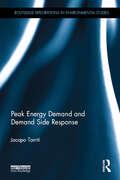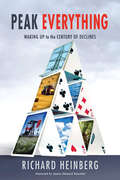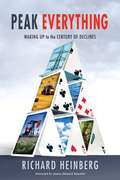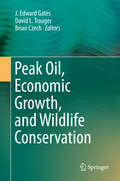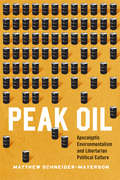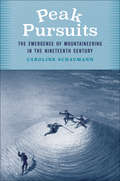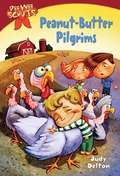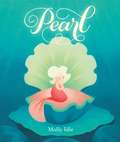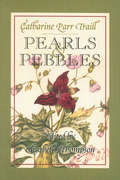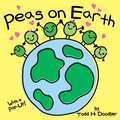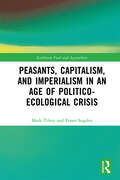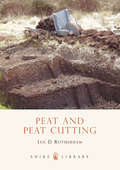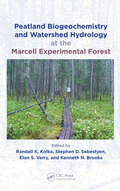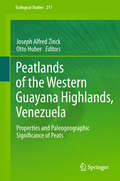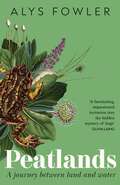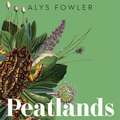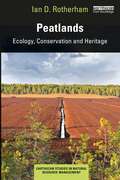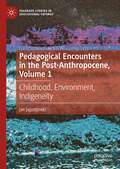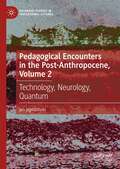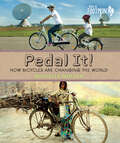- Table View
- List View
Peak Energy Demand and Demand Side Response (Routledge Explorations in Environmental Studies)
by Jacopo TorritiWith different intensities, depending on the season, every morning and evening of any weekday there are the same peaks in electricity demand. Peaks can bring about significantly negative environmental and economic impacts. Demand Side Response is a relatively recent solution in Europe which has the potential to reduce peak demand and ease impending capacity shortages. Peak Energy Demand and Demand Side Response presents evidence on a set of Demand Side Response activities, ranging from price-based to incentive-based programmes and policies. Examples are drawn from different programmes for both residential and non-residential sectors of electricity demand, including Time of Use tariffs, Critical Peak Pricing Automated Demand Controllers and Ancillary Services. The book also looks at the actual energy saving impacts of smart meters, the activities which constitute peak demand and the potential opportunities associated with European smart grids and Capacity Markets. This is the first book presenting comprehensive analysis of the impacts, cost benefits and risks associated with Demand Side Response programmes and policies. It should be of interest to students, scholars and policy-makers in the areas of energy, environmental economics and applied economics.
Peak Everything
by Richard HeinbergThe twentieth century saw unprecedented growth in population, energy consumption, and food production. As the population shifted from rural to urban, the impact of humans on the environment increased dramatically.The twenty-first century ushered in an era of declines, in a number of crucial parameters: Global oil, natural gas, and coal extraction Yearly grain harvests Climate stability Population Economic growth Fresh water Minerals and ores, such as copper and platinum To adapt to this profoundly different world, we must begin now to make radical changes to our attitudes, behaviors, and expectations. Peak Everything addresses many of the cultural, psychological, and practical changes we will have to make as nature rapidly dictates our new limits. This latest book from Richard Heinberg, author of three of the most important books on Peak Oil, touches on the most important aspects of the human condition at this unique moment in time.A combination of wry commentary and sober forecasting on subjects as diverse as farming and industrial design, this book tells how we might make the transition from the Age of Excess to the Era of Modesty with grace and satisfaction, while preserving the best of our collective achievements. A must-read for individuals, business leaders, and policymakers who are serious about effecting real change. Richard Heinberg is a journalist, lecturer, and the author of seven books, including The Party's Over, Powerdown, and The Oil Depletion Protocol. He is one of the world's foremost Peak Oil educators.
Peak Everything: Waking Up to the Century of Declines
by Richard HeinbergHeinberg (New College of California's Campus for Sustainable Living) previously set forth the argument that the world's oil production is peaking and will henceforth go into decline in The Party's Over: Oil, War and the Fate of Industrial Societies. Here he collects 11 essays exploring some of the social, economic, ecological, and political implications of the end of the era of cheap energy. These implications arise out of the recognition that the arrival of peak oil portends also the peak of per-capita consumption levels, economic growth, cheap and easy mobility, technological change and invention, and political stability, but perhaps also the peak of economic inequality, environmental destruction, and greenhouse gas emissions. Distributed by Consortium Books Sales and Distribution. Annotation ©2008 Book News, Inc. , Portland, OR (booknews. com)
Peak Oil, Economic Growth, and Wildlife Conservation
by Brian Czech J. Edward Gates David L. TraugerThe proposed book focuses on one of the most important issues affecting humankind in this century - Peak Oil or the declining availability of abundant, cheap energy--and its effects on our industrialized economy and wildlife conservation. Energy will be one of the defining issues of the 21st Century directly affecting wildlife conservation wherever energy extraction is a primary economic activity and indirectly through deepening economic recessions. Since cheap, abundant energy has been at the core of our industrial society, and has resulted in the technological advancements we enjoy today, the peak in world oil extraction would potentially have major impacts on civilization unless we prepare well in advance. One potential economic solution covered in the book would be a Steady State Economy with a stable population and per capita consumption, particularly in such industrialized countries as the United States. Furthermore, the lack of cheap, abundant energy directly and indirectly affects conservation efforts by professional societies and federal and state agencies, and NGOs concerned with wildlife issues. We need to recognize these potential problems and prepare, as much as possible, for the consequences stemming from them.
Peak Oil: Apocalyptic Environmentalism and Libertarian Political Culture
by Matthew Schneider-MayersonIn recent years, the concept of "peak oil"--the moment when global oil production peaks and a train of economic, social, and political catastrophes accompany its subsequent decline--has captured the imagination of a surprisingly large number of Americans, ordinary citizens as well as scholars, and created a quiet, yet intense underground movement. In Peak Oil, Matthew Schneider-Mayerson takes readers deep inside the world of "peakists," showing how their hopes and fears about the postcarbon future led them to prepare for the social breakdown they foresee--all of which are fervently discussed and debated via websites, online forums, videos, and novels. By exploring the worldview of peakists, and the unexpected way that the fear of peak oil and climate change transformed many members of this left-leaning group into survivalists, Schneider-Mayerson builds a larger analysis of the rise of libertarianism, the role of oil in modern life, the political impact of digital technologies, the racial and gender dynamics of post-apocalyptic fantasies, and the social organization of environmental denial.
Peak Pursuits: The Emergence of Mountaineering in the Nineteenth Century
by Caroline SchaumannAn interdisciplinary cultural history of exploration and mountaineering in the nineteenth century European forays to mountain summits began in the late eighteenth and early nineteenth centuries with the search for plants and minerals and the study of geology and glaciers. Yet scientists were soon captivated by the enterprise of climbing itself, enthralled with the views and the prospect of &“conquering&” alpine summits. Inspired by Romantic notions of nature, early mountaineers idealized their endeavors as sublime experiences, all the while deliberately measuring what they saw. As increased leisure time and advances in infrastructure and equipment opened up once formidable mountain regions to those seeking adventure and sport, new models of masculinity emerged that were fraught with tensions. This book examines how written and artistic depictions of nineteenth-century exploration and mountaineering in the Andes, the Alps, and the Sierra Nevada shaped cultural understandings of nature and wilderness in the Anthropocene.
Peanut Butter Puppies
by Greg MurrayRescue-dog advocate and professional photographer Greg Murray has followed up on the fan favorite Peanut Butter Dogs with an even more irresistible theme: Peanut Butter Puppies. These adorable portraits of rescued dogs, captured in studio with colorful backgrounds and in delightfully amusing detail, will tug at your heartstrings. Prepare to swoon over Wallaby, the seven-month-old heeler; Archie, the eight-month-old Chihuahua; Fiona Wigglesworth, the eight-month-old Boston terrier; Zoey, the nine-month-old mastiff mix, and so many more! Each one-of-a-kind portrait is sure to make your day. Names, ages, and breed/mix accompany each portrait.
Peanut-Butter Pilgrims (Pee Wee Scouts #6)
by Judy DeltonAll the Pee Wee Scouts love to celebrate the holidays, but Thanksgiving is not Molly Duff's favorite one. In fact, Thanksgiving is big trouble for Molly. It's not so bad when the Pee Wees make baskets to hold food for poor people. And it's not so bad when they visit a turkey farm and Sonny Betz takes a turkey home with him. But when Mrs. Peters, their troop leader, tells them about the Pee Wee Thanksgiving play at the town hall, Molly shivers. She's not an actress! She'll forget all her lines. Everyone will laugh. Pilgrims and Indians. Turkeys going gobble, gobble. When you're a Pee Wee Scout, the show must go on! Read more fun books about the Pee Wee Scouts from Bookshare including: #2 Camp Ghost-Away, #9 Spring Sprouts, #12 Bad, Bad, Bunnies, and #33 Halloween Helpers.
Pearl
by Molly IdleCaldecott Honor author-illustrator Molly Idle dazzles with an original mermaid tale about how small, persistent actions can achieve great things.Sometimes the tiniest light can shine the brightest! Like the other mermaids of the deep, Pearl longs to care for the endless beaches, coral reefs, and towering kelp forests of her vast ocean world. So when her mother asks her to tend to a mere grain of sand, Pearl is heartbroken. It takes all her patience and determination to discover how even the littlest mermaid can transform the world.Caldecott Honor-winning author and artist Molly Idle has masterfully crafted a modern classic in this mesmerizing tale about the immense power of small actions.
Pearls and Pebbles
by Catharine Parr Traill Elizabeth ThompsonHow fitting to close out the 20th century with a brand new edition of Pearls & Pebbles by the noted chronicler of pioneer life, Catharine Parr Traill. Published in 1894, Pearls & Pebbles is an unusual book with a lasting charm, in which the author’s broad focus ranges from the Canadian natural environment to early settlement of Upper Canada. Through Traill’s eyes, we see the life of the pioneer woman, the disappearance of the forest, and the corresponding changes in the life of the Native Canadians who have inhabited that forest.Editor Elizabeth Thompson reminds us of the significance of the writings by Traill, the aged author/naturalist, who felt that the hours spent gathering the pebbles and pearls from her notebooks and journals written in the backwoods of Canada was not time wasted.
Peas on Earth
by Todd H. DoodlerPeas on Earth uses a simple play on words to portray the basic concepts of peace, harmony, getting along with all kinds of people, and being green in a manner that young kids will grasp. And it will resonate more as they grow older. Adult caregivers will chuckle over the peas/peace references while young children will relate to the important messages about our earth and those of us who live on it. The artwork is colorful, charming, and perfect for the board book crowd. And, as an added value, there is a simple pop-up at the end of the book.From the Board edition.
Peasants, Capitalism, and Imperialism in an Age of Politico-Ecological Crisis (Earthscan Food and Agriculture)
by Mark Tilzey Fraser SugdenThis book utilises a new theoretical approach to understand the dynamics of the peasantry, and peasant resistance, in relation to capitalism, state, class, and imperialism in the global South. In this companion volume to Peasants, Capitalism, and the Work of Eric R. Wolf, the authors further develop their thinking on agrarian transitions to capitalism, the development of imperialism, and the place of the peasantry in these dynamics, with special reference to the global South in an era of politico-ecological crisis. Focusing on the political role of the peasantry in contested transitions to capitalism and to modes of production outside of, and beyond, capitalism, the book contends that an understanding of these dynamics requires an analysis of class struggle and of the resources, material and discursive, that different classes can bring to bear on this struggle. The book focuses on the rise of capitalism in the global South within the context of imperial subordination to the global North, and the place of the peasantry in shaping and resisting these dynamics. The book presents case studies of contested transitions to agrarian capitalism in Bolivia, Ecuador, Guatemala, Mexico, Peru, and South Asia. It also examines the case of transition to a post-capitalist mode of production in Cuba. The book concludes with an assessment of the nature of capitalism and imperialism within the context of the contemporary politico-ecological crisis, and the potential role of the peasantry as agent of emancipatory change towards social and environmental sustainability. This book will be of great interest to students and researchers in the areas of peasant studies, rural politics, agrarian studies, development, and political ecology.
Peasants, Culture and Indigenous Peoples
by Rodolfo StavenhagenThis last volume in a trilogy published on the occasion of the 80th birthday of Rodolfo Stavenhagen, professor emeritus of El Colegio de Mexico, includes eight essays on Peasants, Culture and Indigenous Peoples: Critical Issues; Basic Needs, Peasants and the Strategy for Rural Development (1976); Cultural Rights: a Social Science Perspective (1998); The Structure of Injustice: Poverty, Marginality, Exclusion and Human Rights (2000); What Kind of Yarn? From Color Line to Multicolored Hammock: Reflections on Racism and Public Policy (2001); The United Nations Special Rapporteur on the Rights of Indigenous Peoples (2012); A Report on the Human Rights Situation of Indigenous Peoples in Asia (2007); Report on the Impact of Megaprojects on the Rights of Indigenous Peoples (2003); and Study Regarding the Best Practices to Implement the Recommendations of the Special Rapporteur (2007). These texts address human rights issues, especially those that arose when Stavenhagen was servinged as United Nations special rapporteur on the rights of indigenous peoples.
Peat and Peat Cutting
by Ian RotherhamFor thousands of years peat was the main fuel that that warmed houses all over the British Isles, and the mark of the peat cutter is written deep in the landscape. This book is a celebration of a cultural history that extended from the Iron Age to the twentieth century. It tells the story of the use of peat for fuel in the British Isles, and the people who cut it. It also examines the methods of cutting, the tools that were used, and the organization of cutting. It chronicles the beginning of commercial extraction and the exhaustion of this precious resource.
Peatland Biogeochemistry and Watershed Hydrology at the Marcell Experimental Forest
by Kenneth N. Brooks Randall K. Kolka Stephen D. Sebestyen Elon S. VerryThe Marcell Experimental Forest (MEF) in Minnesota serves as a living laboratory and provides scientists with a fundamental understanding of peatland hydrology, acid rain impacts, nutrient and carbon cycling, trace gas emissions, and controls on mercury transport in boreal watersheds. Its important role in scientific research continues to grow as t
Peatlands of the Western Guayana Highlands, Venezuela
by Joseph Alfred Zinck Otto HuberThe Guayana Highlands in northeastern tropical America, rising from lowland rain forests and savannas up to 3000 m elevation, are characterized by ancient tablelands called tepuis. The peatlands that developed on the tepuis constitute unique and fascinating ecosystems and are the focus of this volume, which starts with an overview of tropical and subtropical peats, followed by an introduction to the geo-ecological features of the Guayana region as a whole, with special emphasis on the diversity of the vegetation cover from lowlands to uplands to highlands. The core subject centers on the properties and dating of the peat deposits and the interpretation of the chronological record in terms of past environmental changes. The well illustrated book will appeal to a broad range of scientists interested in tropical highland peats, including quaternarists, soil scientists, geomorphologists, geographers, geologists, ecologists, botanists, hydrologists, conservationists, and land use planners.
Peatlands: A Journey Between Land and Water
by Alys FowlerA beautiful, urgent and personal exploration of bogs and the role they must play in saving our planet - for fans of Otherlands and The Last Rainforests of Britain 'A fascinating, impassioned invitation into the hidden mystery of bogs' - OLIVIA LAING, author of The Garden Against Time'Enchanting . . . If you've ever looked at a wetland and wanted to know it better, Fowler is an ideal guide: knowledgeable, passionate, and above all, joyous and personable in her prose.' - JESSICA J. LEE, author of Two Trees Make a Forest'The book throws a sharp light on the plight of bogs - places that come spectacularly to life under Fowler's analytic and passionate gaze. A delight to read but also a sobering education.' - TOM STUART-SMITH'The curious, still silence of peat bogs is so much at odds with their deep and ancient complexities. This book, so immersive, thoughtfully penned and well-observed makes an intimate connection to these often overlooked and enormously precious places. It makes you want to tread lightly and to look deeper.' - DAN PEARSON -------'Why do I like bogs so much? I think it is because I feel very at home with them, I think this has something to do with my queerness and their queer nature as a space.' The value of peat bogs as a natural resource and haven of biodiversity is undisputed, yet few of us have been lucky enough to experience their beauty and richness. In Peatlands, Wainwright Prize-shortlisted author Alys Fowler calls for us to sink deep into the dark, black earths of these rugged places and take a close look at the birds, animals, plants and insects that live within them.Living in Wales nestled between bogs makes Alys Fowler's Peatlands both personal and illuminating. Her odyssey takes her deep into the Flow Country, to the remote Border Mires, through Bannau Bracheinoig, the Peak District and Ireland, creating an intimate picture of these magical places and the people who care for them.
Peatlands: A Journey Between Land and Water
by Alys FowlerA beautiful, urgent and personal exploration of bogs and the role they must play in saving our planet - for fans of Otherlands and The Last Rainforests of Britain 'A fascinating, impassioned invitation into the hidden mystery of bogs' - OLIVIA LAING, author of The Garden Against Time'Enchanting . . . If you've ever looked at a wetland and wanted to know it better, Fowler is an ideal guide: knowledgeable, passionate, and above all, joyous and personable in her prose.' - JESSICA J. LEE, author of Two Trees Make a Forest'The book throws a sharp light on the plight of bogs - places that come spectacularly to life under Fowler's analytic and passionate gaze. A delight to read but also a sobering education.' - TOM STUART-SMITH'The curious, still silence of peat bogs is so much at odds with their deep and ancient complexities. This book, so immersive, thoughtfully penned and well-observed makes an intimate connection to these often overlooked and enormously precious places. It makes you want to tread lightly and to look deeper.' - DAN PEARSON -------'Why do I like bogs so much? I think it is because I feel very at home with them, I think this has something to do with my queerness and their queer nature as a space.' The value of peat bogs as a natural resource and haven of biodiversity is undisputed, yet few of us have been lucky enough to experience their beauty and richness. In Peatlands, Wainwright Prize-shortlisted author Alys Fowler calls for us to sink deep into the dark, black earths of these rugged places and take a close look at the birds, animals, plants and insects that live within them.Living in Wales nestled between bogs makes Alys Fowler's Peatlands both personal and illuminating. Her odyssey takes her deep into the Flow Country, to the remote Border Mires, through Bannau Bracheinoig, the Peak District and Ireland, creating an intimate picture of these magical places and the people who care for them.
Peatlands: A Journey Between Land and Water
by Alys Fowler'Why do I like bogs so much? I think it is because I feel very at home with them, I think this has something to do with my queerness and their queer nature as a space.'The value of peat bogs as a natural resource and haven of biodiversity is undisputed, yet few of us have been lucky enough to experience their beauty and richness. In Peatlands, Wainwright Prize-shortlisted author Alys Fowler calls for us to sink deep into the dark, black soils of these rugged places and take a close look at the birds, animals, plants and insects that live within them. Living in North Wales next to a huge peat bog makes Alys Fowler's Peatlands both personal and illuminating. Her odyssey takes her deep into the Flow Country, to the remote Border Mires, up the Brecon Beacons and the Peak District, creating an intimate picture of these magical places and the people who care for them.
Peatlands: Ecology, Conservation and Heritage (Earthscan Studies in Natural Resource Management)
by Ian D. RotherhamThis book provides an introduction to peatlands for the non-specialist student reader and for all those concerned about environmental protection, and is an essential guide to peatland history and heritage for scientists and enthusiasts. Peat is formed when vegetation partially decays in a waterlogged environment and occurs extensively throughout both temperate and tropical regions. Interest in peatlands is currently high due to the degradation of global peatlands which is disrupting hydrology and contributing to greenhouse gas emissions. This book opens by explaining how peat is formed, its properties and worldwide distribution, and defines related terms such as mires, wetlands, bogs and marshes. There is discussion of the ecology and wildlife of peatlands as well as their ability to preserve pollen and organic remains as environmental archives. It also addresses the history, heritage and cultural exploitation of peat, extending back to pre-Roman times, and the degradation of peatlands over the centuries, particularly as a source of fuel but more recently for commercial horticulture. Other chapters discuss the ecosystem services delivered by peatlands, and how their destruction is contributing to biodiversity loss, flooding or drought, and climate change. Finally, the many current peatland restoration projects around the world are highlighted. Overall the book provides a wide-ranging but concise overview of peatlands from both a natural and social science perspective, and will be invaluable for students of ecology, geography, environmental studies and history.
Peculiar Primates: Fun Facts About These Curious Creatures
by Debra Kempf ShumakerFrom flossing and howling, to building nests and thumping chests, this delightful follow up to Freaky, Funky Fish explores the amazing things primates do. All primates climb and breathe in air. They have big brains and hands and hair. But. . . some live alone, some live in groups. One primate has a nose that droops. Peculiar Primates is an adorable picture book with a scientific—and child-friendly—underpinning. With examples of different primates for each description, as well as extensive backmatter explaining the fascinating science behind their behaviors, this bizarre book captures the wonders of our ecosystem.
Pedagogical Encounters in the Post-Anthropocene, Volume 1: Childhood, Environment, Indigeneity (Palgrave Studies in Educational Futures)
by jan jagodzinskiThis volume, the first of a two volume set, addresses three major areas in response to the post-Anthropocene: childhood, environment and indigeneity. Each of these areas is broadly addressed in relation to the concerns that have arisen both theoretically and educationally. The author terms these to be encounters as each area presents a particular problematic when addressing the phase change that the planet is undergoing where the anthropogenic labour of global humanity is contributing to climate change, endangering our very existence. There has been a concerted effort to overcome the nature-culture divide in education. The author reviews this development in the first section where there has been a particular emphasis placed on childhood education. In the second section he turns to the pedagogical theories that are attempting to overcome this same divide in environmental and science education. The last section attempts to bring into the conversation the vast literature on Indigeneity and their attempts to revise traditional education to meet these extraordinary times.
Pedagogical Encounters in the Post-Anthropocene, Volume 2: Technology, Neurology, Quantum (Palgrave Studies in Educational Futures)
by jan jagodzinskiAs a follow up to Pedagogical Encounters in the Post-Anthropocene, Volume I, this book addresses three major areas in response to the post-Anthropocene: Technology, Neurology, Quantum. Each of these areas is broadly addressed in relation to the concerns that have arisen both theoretically and educationally. As in Volume I, the author terms these to be encounters as each area presents a particular problematic when addressing the phase change that the planet is undergoing where the anthropogenic labour of global humanity is contributing to climate change, endangering our very existence. Technology in education has been a significant development. There is a concerted effort to review this development placing stress on the rise of learning machines and algorithms. In the second encounter the vast literature on neurology is addressed, especially neurodiversity and the various symptoms that have emerged in the post-Anthropocene era. The last section reviews issues related to quantum theory as this is fundamental to tensions between physics and metaphysics. The volume concludes with the author’s own pedagogical proposal for the future.
Pedal It!: How Bicycles are Changing the World (Orca Footprints #2)
by Michelle MulderPedal It! celebrates the humble bicycle and shows you why and how bikes can make the world a better place From the very first boneshakers to the sleek racing bikes of today, from handlebars to spokes to gear sprockets, bicycles have continued to capture our collective fascination. Not only can bikes be used to power computers and generators, but they can also reduce pollution, promote wellness and get a package across a crowded city—fast! Informative but not didactic, Pedal It! encourages young readers to be part of the joy of cycling.

